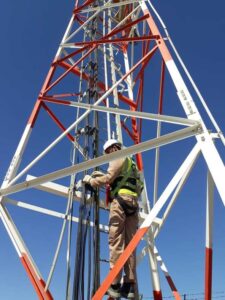In an increasingly connected world, reliable telecommunications infrastructure is crucial for economic growth, social development, and technological advancement. Nigeria, Africa’s most populous nation and a rapidly growing economy, has seen an exponential increase in demand for communication services. To meet this demand, the erection of communication towers has become a cornerstone of the country’s telecommunication revolution.
The Need for Communication Towers in Nigeria
Nigeria boasts over 200 million people, with a growing reliance on mobile phones, internet connectivity, and digital services. Yet, the country’s telecommunications landscape faces significant challenges, including limited network coverage, especially in rural areas, and a need for higher broadband penetration. The solution? Building communication towers across urban and rural regions to bridge this gap.
Communication towers are essential in providing the infrastructure needed for telecommunication companies to deliver voice, data, and internet services effectively. These towers enable stronger signal reception, wider network coverage, and faster data transmission, ensuring seamless connectivity for individuals, businesses, and government operations.

The Process of Communication Tower Erection
Erecting a communication tower in Nigeria involves several critical stages, requiring planning, skilled labor, and adherence to regulations. Here is an overview of the process:
1. Site Survey and Selection
The first step in erecting a communication tower is identifying the right location. Telecom companies and engineers conduct surveys to select sites with optimal signal propagation while considering terrain, accessibility, and the presence of existing infrastructure. Environmental factors such as wind load, soil stability, and proximity to power lines are also carefully analyzed.
2. Obtaining Approvals and Permits
To ensure safety and compliance with Nigerian laws, companies must obtain permits from relevant authorities such as the Nigerian Communications Commission (NCC) and state/local governments. This step often involves community engagement to address concerns related to safety, health, and environmental impact.
3. Foundation and Civil Works
Once approved, the foundation of the tower is prepared. This stage involves excavation, pouring concrete, and installing reinforcements to ensure stability. A solid foundation is vital to support the tower’s weight and withstand environmental pressures like heavy winds or storms.
4. Tower Installation
Communication towers, which may range from monopoles and self-supporting lattice towers to guyed masts, are erected in phases. Technicians assemble the tower components on-site, using cranes and other equipment to lift and secure sections into place. The installation process requires precision and safety protocols to prevent accidents and ensure structural integrity.
5. Equipment Installation and Testing
After the tower is erected, antennas, transmitters, and other telecommunication equipment are installed. Technicians then conduct rigorous testing to ensure the system operates at full capacity, delivering high-quality signals and seamless coverage to the surrounding areas.
6. Ongoing Maintenance
Erecting a communication tower is just the beginning. Routine maintenance, including inspections, repairs, and equipment upgrades, is essential to ensure optimal performance and longevity.
Challenges in Communication Tower Erection
Despite the clear benefits, erecting communication towers in Nigeria is not without its challenges. These include:
- Infrastructure Deficits: Poor road access, inconsistent power supply, and difficult terrain in rural areas often delay projects.
- Regulatory Bottlenecks: Lengthy approval processes can hinder the swift deployment of towers.
- Community Opposition: Concerns about radiation, health effects, and land use sometimes create resistance from local communities.
- Security Issues: Vandalism, theft of equipment, and instability in certain regions pose risks to communication towers.
However, innovative solutions such as solar-powered towers, community engagement programs, and strengthened security measures are being implemented to address these challenges.
The Impact on Connectivity and Development
The erection of communication towers in Nigeria has far-reaching impacts on the country’s development. Improved network coverage leads to:
- Enhanced Communication: Citizens enjoy better voice and internet services, allowing for seamless personal and professional communication.
- Economic Growth: Businesses benefit from improved connectivity, boosting e-commerce, digital banking, and other services.
- Education and Healthcare Access: Increased connectivity facilitates e-learning platforms and telemedicine, bridging gaps in education and healthcare delivery.
- Job Creation: The telecom industry creates employment opportunities in construction, engineering, and maintenance.
The Future of Communication Infrastructure in Nigeria
The future of communication tower erection in Nigeria is bright. With the federal government’s commitment to achieving 70% broadband penetration by 2025, the demand for towers will continue to grow. Investments in 5G technology, rural connectivity initiatives, and smart infrastructure projects will further drive the expansion of the telecommunications sector.
Collaboration between telecom companies, regulatory agencies, and communities will be key to overcoming challenges and ensuring sustainable infrastructure development. As Nigeria strives to bridge its digital divide, the erection of communication towers will remain central to unlocking the country’s potential for growth and connectivity.
Conclusion
Communication tower erection in Nigeria is more than just building structures; it is about connecting people, empowering communities, and driving progress. While challenges remain, the opportunities far outweigh them. With continued investment and innovation, Nigeria’s telecommunication infrastructure will continue to evolve, creating a more connected and prosperous nation.
